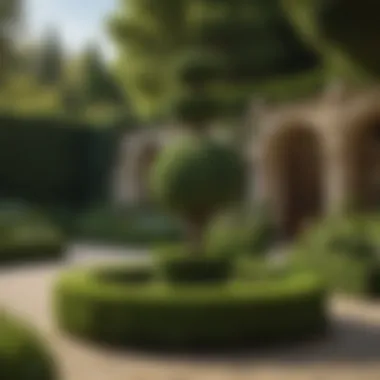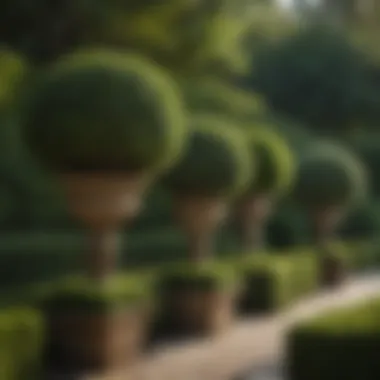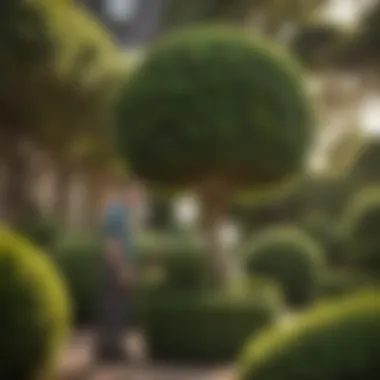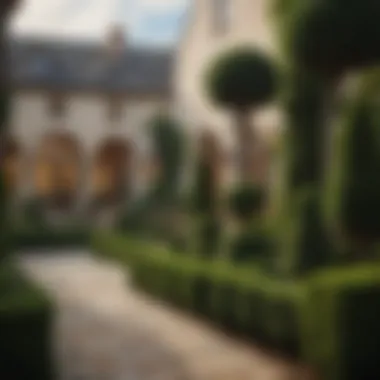Exploring Frontgate Outdoor Topiary for Luxury Landscaping


Intro
Frontgate outdoor topiary represents a unique element in the realm of luxury landscaping. As discerning individuals seek to elevate their outdoor spaces, the art of topiary becomes a focal point that not only enhances beauty but also contributes to the overall elegance of a property. This guide will cover the various aspects of incorporating Frontgate topiary into your landscaping plans, offering insights on style, maintenance, and practical tips to achieve visually stunning results.
Outdoor Decor Ideas
Integrating Frontgate topiary into your outdoor decor can transform your landscaping into a sophisticated sanctuary. The appeal lies not just in the plants themselves, but in how they can be styled alongside other elements of outdoor design.
Seasonal Inspirations
Each season brings unique opportunities to showcase topiary arrangements. In spring, fresh blooms can complement the lush green of the topiary. Summer can be a time of vibrant colors, where colorful annuals are positioned nearby to create contrast. Autumn allows for a more rustic palette, while in winter, evergreen topiaries can be illuminated for a striking effect.
Furniture Selection
Choosing the right furniture is vital in achieving a cohesive look. Opt for elegant outdoor sofas, chairs, and tables that harmonize with topiary features. Materials such as teak or wrought iron bring a classic feel, while modern synthetic options offer durability.
Decorative Lighting
Lighting adds ambiance to outdoor spaces. Strategically placed lighting can highlight topiary forms, creating focal points at night. Consider using sconces, lanterns, or embedded lighting in walkways to enhance visibility and aesthetics.
Plant Arrangements
Pairing topiary with carefully chosen plants can elevate the landscaping. Consider low-maintenance perennials or fragrant herbs as companions. Group plants of varied heights and colors to create dimension without overwhelming the topiary.
Hardscaping Solutions
Incorporating hardscaping elements such as pathways, walls, or terraces can create intentional spaces for topiary. Materials like flagstone, gravel, or decorative concrete can serve to frame and highlight your green features, establishing a refined look.
Sustainable Practices
Practicing sustainability in landscaping is becoming increasingly important. Use native plants alongside topiary to promote biodiversity. Choose low-water varieties to save on irrigation while maintaining a lush appearance.
"Topiary not only beautifies a space; it also establishes character and structure within a landscape."
End
Incorporating Frontgate outdoor topiary into your landscaping plan offers both beauty and practicality. The thoughtful integration of these elements can elevate an outdoor space, making it a retreat that feels luxurious and inviting. Whether it’s a lush garden or a minimalist patio, understanding how to effectively use topiary and other design elements will enhance your exterior aesthetic.
Preamble to Topiary
Topiary represents a unique blend of art and horticulture, offering an elegant approach to landscaping. This section lays the groundwork for understanding its role in enhancing outdoor aesthetics. Topiary is not merely about shaping plants; it embodies a historical tradition that has evolved into a sophisticated design element in contemporary landscapes. The importance of delving into this topic lies in its influence on luxury landscaping, showcasing how creativity and nature can coexist harmoniously.
Definition and Historical Context
Topiary is defined as the art of clipping and training plants into decorative shapes. Its origins trace back to ancient Rome, where wealthy estates featured skilled gardeners crafting intricate designs from greenery. Over the centuries, topiary has undergone various transformations, reflecting the tastes and styles of different eras.
In the Renaissance, topiary blossomed in gardens across Europe, particularly in Italy and France. Gardeners employed geometric shapes, animals, and mythical creatures, creating living sculptures that conveyed wealth and taste. Today, this art form continues to thrive, particularly within luxury settings, reinforcing its cultural significance.
The Art of Shaping Plants
Creating topiary is a meticulous process that requires skill and an understanding of plant behavior. The choice of plant species is crucial; not all plants can adapt to shaping processes. Common choices include boxwood, yew, and holly, all known for their dense foliage and tolerance to pruning.
The shaping process generally involves the following steps:
- Select Your Plant: Choose suitable species based on climate and desired shape.
- Initial Shaping: Begin with basic forms; this sets the foundation for more complex designs.
- Regular Maintenance: Adjust shapes as plants grow; this may involve frequent trimming.
The result is often a stunning focal point in gardens, adding both structure and beauty. The practice of topiary, therefore, not only supports aesthetic goals but also creates a layered experience in outdoor spaces.
"Topiary is an embodiment of nature's elegance, demanding patience and skill to reshape greenery into artistic expressions."
Understanding Frontgate Topiary
Frontgate outdoor topiary is not just about aesthetics. It embodies a philosophy of luxury landscaping, where artistry meets nature. Understanding this concept allows one to appreciate the unique designs and commitment to quality that Frontgate offers in its products. The interplay between form and function defines the essence of their topiary, making it not only a visual delight but also an enhancement of outdoor living spaces.


Overview of Frontgate's Offerings
Frontgate is known for its extensive selection of high-quality outdoor topiary options. They provide traditional shapes, modern styles, and seasonal decorations tailored to suit diverse outdoor environments. Their offerings include:
- Artificial Topiary: Made from durable materials designed to withstand outdoor elements while maintaining an appealing look year-round.
- Live Plants: Varieties that can be nurtured and trained into various shapes, offering a dynamic element to landscaping.
- Accessories: Specialized pots and supports that complement topiaries and enhance their presence in your garden.
Each selection is curated to ensure it meets a high standard of luxury and functionality, appealing to both aesthetic and practical needs.
Quality and Craftsmanship
The craftsmanship behind Frontgate topiary is exemplary. Each piece is designed with attention to detail which reflects the brand's commitment to quality. The materials used are carefully selected to withstand the rigors of outdoor use. This includes UV-resistant fabrics for artificial models, and hardiness in live specimens that adapts well to varying climates.
Furthermore, the design process involves not just aesthetics but also resilience. The topiary shapes are engineered to remain stable and maintain their form over time, making it a worthy investment for any discerning homeowner seeking long-lasting beauty in their landscape.
"A well-placed topiary can transform a mundane space into a refined outdoor retreat, marrying elegance with nature."
The process involved in crafting these items ensures that every piece possesses uniqueness. Each topiary reflects both artistic vision and botanical knowledge, resulting in products that not only beautify but also enhance the overall integrity of an outdoor area.
Types of Outdoor Topiary
Outdoor topiary serves as a key element in luxury landscaping, offering both aesthetic appeal and a sense of elegance to outdoor spaces. Understanding the various types of topiary can significantly enhance a landscape design, ensuring that it meets the unique needs and preferences of property owners. Each type of topiary has distinct characteristics that can impact the overall visual impression of any outdoor environment.
Traditional Topiary Shapes
Traditional topiary shapes are a hallmark of classic garden design. These forms often include geometric patterns such as spheres, cones, and spirals. They date back to ancient Roman gardens, where they symbolized wealth and sophisticated taste. The precision required to shape plants into these forms reflects a dedication to craftsmanship. Common plants used in traditional topiary include boxwood, yew, and holly.
Here are some considerations when incorporating traditional shapes:
- Timeless Aesthetic: Creates a formal and structured look that complements classical architecture.
- Scale Variability: Available in various sizes, making it adaptable for different garden spaces.
- Texture Addition: Offers texture by contrasting the smooth forms with foliage.
Modern Interpretations
Modern interpretations of topiary expand beyond the classic shapes to include more abstract designs. These updates can range from organic, fluid forms to quirky shapes inspired by animals or famous artistic styles. The use of various plants, such as evergreens and flowering shrubs, allows for creative flexibility.
In modern landscaping, topiary can be utilized to:
- Enhance Creativity: Allows for unique statements that reflect personal style.
- Integrate with Other Elements: Works well alongside other landscaping features like water fountains, modern sculptures, and lighting.
- Functional Spaces: Provides structure and definition for outdoor rooms or seating areas.
Seasonal Variations
Seasonal variations in topiary add dynamism to landscaped areas. Choices in plants can create colorful changes throughout the year. For instance, evergreens maintain their shape year-round, while deciduous selections bring seasonal interest with their foliage color shifts. Seasonal topiary can be further complemented by adding seasonal flowers or ornamental grasses.
Key considerations for seasonal variations include:
- Seasonal Interest: Engages the viewer throughout different times of the year.
- Maintenance Needs: Understanding the care requirements for different species is essential for upkeep.
- Planning for Change: Designing layouts that account for seasonal plant cycles ensures continual visual impact.
Selecting the Right Topiary for Your Space
Selecting the right topiary for your space is a critical step in the landscaping process. Topiary serves not just an aesthetic purpose, but also reflects your taste and enhances the overall ambiance of your outdoor area. The proper choice can elevate your garden from ordinary to extraordinary. One should consider various elements, such as the local climate, the size of the area, and how the topiary complements existing architecture.
Assessing Your Outdoor Environment
The first step in choosing suitable topiary involves assessing your outdoor environment. Evaluate factors such as sunlight, soil type, and moisture levels. These elements dictate what types of plants will thrive in your particular setting. For instance, shaded areas may not support sun-loving varieties, while well-drained soils favor certain species of shrubs.
Additionally, think about the overall design themes in your outdoor space. If your home has a modern aesthetic, sleek and simplified forms may be appropriate, whereas traditional architecture might benefit from more intricate shapes, such as spirals or balls.
Considerations for Size and Scale
Size and scale are pivotal when selecting topiary. Large outdoor spaces can accommodate bigger specimens, while smaller areas may require more compact varieties. A balance must be struck to ensure the topiary does not overwhelm or appear dwarfed by other elements in the landscape.
Remember these points:
- Large topiary specimens can serve as statement pieces.
- Smaller varieties work well for layering and depth.
- Always visualize how interiors or exteriors engage with the garden area.
Getting the proportions right can be the difference between a harmonious landscape and a disjointed one.


Choosing Varieties for Different Climates
Finally, selecting the right varieties of topiary requires understanding your climate zone. For example, boxwood is often favored in temperate climates due to its hardiness and ability to be shaped easily. Conversely, in warmer regions, options like rosemary or juniper may be preferred.
Important Tips for Selecting Varieties:
- Research local climate conditions to encourage healthy growth.
- Consult with nurseries about what others in your area use successfully.
- Remember that native varieties often cope better with local pests and diseases.
Choosing a topiary variety that aligns with your specific climate conditions not only ensures longevity but also allows for a more cohesive aesthetic throughout the changing seasons.
Select your topiary thoughtfully; it will serve as a lived experience in your landscape, enhancing both beauty and quality of life.
Incorporating Topiary into Landscape Design
Incorporating topiary into landscape design is a crucial aspect of creating a refined outdoor space. The presence of topiary introduces an element of sophistication and artistry that transcends mere decorative style. This design choice blurs the lines between nature and intentional aesthetics. Topiary serves as a transformative feature in any outdoor area. It contributes to an upscale atmosphere, elevating the overall appearance of gardens, patios, and pathways.
Importance of Topiary in Design:
Topiary can seamlessly blend into various architectural styles. This adaptability makes it a favored element among luxury landscapers. When placed strategically, topiary shapes can guide the viewer's eye through a landscape. They create structure, enhance visual depth, and provide a sense of order. Thus, incorporating topiary is not only about beautification but also functionality in landscape design.
Complementing Architecture with Topiary
Integrating topiary with architecture is essential for visual cohesion in landscaping. Whether a contemporary villa or a classic estate, well-placed topiary can enhance architectural features. For example, rounded boxwood balls can soften harsh lines of modern architecture, while ornate shapes might highlight classical elements.
- Benefits of Complementing Architecture:
- Visual Continuity: Topiary helps to bridge the gap between the building and the landscape, creating a seamless transition.
- Enhanced Features: Topiary can draw attention to architectural highlights such as doorways, windows, or entry paths.
- Color and Texture: Different foliage, from rich green to variegated leaves, can add layers to the overall appearance.
Creating Focal Points
Focal points are integral to effective landscape design, and topiary excels in this area. Arranging topiary pieces as central visual anchors provides direction and emphasis within the outdoor space. A well-designed topiary arrangement can inspire conversation and admiration.
- Considerations for Creating Focal Points:
- Scale and Proportion: Ensure the size of the topiary is appropriate to the surrounding elements.
- Positioning: Place topiary at eye level or at strategic points for maximum visibility.
- Variations: Mix different shapes and sizes to create dynamic visual interest without overwhelming the space.
"Topiary not only frames your outdoor rooms but also invites contemplation through its elegant forms."
Maintaining Balance and Harmony
Balance is a fundamental principle in landscaping, and topiary can contribute significantly to this aspect. When incorporating topiary, aim for harmony among all elements in the landscape, including flowers, pathways, and other plants. One way to achieve balance is through repetition of shapes or colors, creating a cohesive look.
- Tips for Maintaining Balance:
- Symmetrical Arrangements: Pairing identical topiary pieces on either side of a pathway can establish a sense of order.
- Varying Heights: Incorporate topiary of differing heights, ensuring they still complement one another.
- Textural Contrast: Balance smooth topiary shapes with more textured planting around them for visual depth.
In summary, integrating topiary into landscape design provides opportunities for luxury, personalization, and aesthetic appeal. Each element should serve a purpose while enhancing the overall beauty of the space.
Care and Maintenance of Topiary
Caring for topiary is crucial to maintaining its aesthetic appeal and structural integrity. Well-maintained topiary not only enhances the beauty of a landscape but also reflects the artistry and dedication of the gardener. Regular care, including proper watering, pruning, and pest management, is essential. These tasks ensure that the plants remain healthy, vibrant, and structurally sound. Understanding the specific needs of topiary can lead to long-lasting and visually stunning outdoor arrangements.
Watering Requirements
Watering is fundamental in topiary care. The amount of water required depends on factors such as the plant species, soil type, and weather conditions. Generally, topiary plants prefer evenly moist soil. Overwatering can lead to root rot, while underwatering can cause stress and wilting. It is advisable to check the soil moisture before watering.
A simple test is to insert a finger about an inch into the soil. If it feels dry, it is time to water. Drip irrigation systems are often beneficial, as they provide consistent moisture without oversaturating the roots. In hot weather, frequency of watering may need to increase, while cooler temperatures may allow for less.
Pruning Techniques
Pruning is an essential technique for maintaining the desired shapes and promoting healthy growth in topiary plants. Regular trimming helps to keep the form crisp and well-defined. Timing is also important; the best time to prune is typically in late spring or early summer when growth is actively taking place.
Using sharp secateurs is recommended to make clean cuts. Start with small branches and gradually work your way toward the larger ones. Create a plan for the shape you desire, and measure frequently to ensure uniformity. Also, be cautious not to remove more than one-third of the foliage in one session.
Proper pruning shapes the plant and encourages fuller growth, leading to a more robust structure.


Dealing with Pests and Diseases
Managing pests and diseases is vital for the health of topiary. Common pests include aphids, spider mites, and scale insects. Regular inspection helps identify these problems early. If pests are detected, organic insecticidal soap may be used to treat them.
It is also important to maintain a balanced ecosystem in the garden. Attracting beneficial insects, such as ladybugs, can provide natural pest control. Moreover, monitoring for signs of disease—such as yellowing leaves or wilting—can prevent further complications. Proper air circulation and avoiding overcrowding will also help reduce the risk of fungal diseases.
Topiary Trends in Outdoor Design
Topiary trends play a significant role in shaping the landscape design industry. As people's preferences evolve, these trends reflect a shift toward more sustainable and modern approaches. This section discusses how topiary not only enhances aesthetic appeal but also emphasizes ecological responsibility and innovative design principles. The right choices in topiary can elevate a landscape, making it luxurious yet aligned with contemporary values and practices.
Sustainable Materials and Practices
The rise of sustainability in landscaping is influencing the selection of materials used in creating topiary. Many designers now favor eco-friendly materials that limit environmental impact. This not only aligns with global efforts to conserve nature but also adds a certain authenticity and warmth to outdoor spaces.
- Biodegradable and Recyclable Materials: Products made from biodegradable or recycled elements are becoming more common. This reflects a commitment to minimizing waste and enhancing the ecological footprint.
- Natural Fertilizers: Usage of organic fertilizers promotes healthier plant growth and reduces chemical runoff, which can harm local ecosystems.
- Water-efficient irrigation systems: These systems conserve water, ensuring that the topiary remains lush without unnecessary consumption of resources.
These practices contribute towards creating a landscape that looks elegant while caring for the environment.
Integration with Modern Landscaping Trends
Modern landscaping now incorporates various distinctive elements, and topiary is at the forefront of this movement. Its ability to adapt and merge seamlessly with new styles makes it a valuable asset. Notably, three trends are emerging:
- Minimalist Designs: Less is more. Topiary can be used to introduce simple yet striking forms, allowing spaces to feel airy and spacious.
- Mixed Planting: Combining topiary with other plant forms and textures creates visual interest. This mixture can enhance both the traditional and contemporary landscapes.
- Vertical Gardens: Vertical gardening has gained traction in urban settings. Topiary can complement vertical structures, adding depth and dimension to areas with limited ground space.
“Modern topiary is not just an art; it is a reflection of a lifestyle that prioritizes elegance and sustainability.”
These integrations provide a great opportunity for luxury landscapers to create memorable outdoor spaces. Outlining these trends encourages deeper engagement with the natural environment while maintaining aesthetic standards.
Case Studies of Successful Topiary Use
When considering the integration of topiary in landscaping, examining successful case studies provides valuable insights. These studies highlight not only the versatility and aesthetic appeal of topiary but also its potential to enhance various spaces, both private and public. They underline the thoughtfulness required to effectively select and position these sculpted forms, allowing landscape designers to visualize the impact of their choices.
Incorporating topiary can serve multiple purposes in design, such as creating visual interest, establishing structure, and guiding visitors through different areas of a garden. Case studies particularly illustrate how unique topiary figures can reflect the personality of a space, making them integral to cohesive design narratives.
Private Gardens
In private gardens, topiary often acts as a focal point, distinguishing areas within the landscape. For example, the use of formal clipped hedges and carefully shaped spiral topiaries can create a refined atmosphere, fitting for any elegant residential space. Consider the case of the Harrison residence in Connecticut; the owners employed Frontgate's impressive collection to complement their expansive lawn and pool area.
- Design Aspects: The garden features several large boxwood topiaries to frame the outdoor seating areas. These well-maintained shapes add sophistication, harmonizing with the classical facade of the house.
- Personalization: The owners included unique motifs, such as animal shapes, that align with their family's interests. This personal touch makes the garden distinctive and inviting.
- Maintenance Considerations: Ongoing care is essential. The owner has shared the importance of consistent pruning and watering routines to maintain the topiaries’ sharp aesthetics throughout the seasons.
Public Spaces and Parks
Public gardens and parks benefit significantly from the use of topiary. They enhance the visitor experience by providing sculptural elements that invite closer inspection and exploration. A notable example is the Brookside Gardens in Maryland, where intricate topiary designs are strategically placed to enhance the flow of foot traffic.
- Community Engagement: The use of topiary in this setting has turned the park into a beloved community space. Events like seasonal flower shows often feature these shapes, drawing in visitors eager to explore.
- Architectural Balance: Topiaries here complement the natural settings, creating a balance with the architectural features of nearby buildings and pathways.
- Educational Aspect: Some installations serve an educational purpose, with signs explaining the species used and their care, fostering an appreciation for thoughtful landscaping among visitors.
By evaluating these case studies, it becomes clear how Frontgate’s outdoor topiary can transform both private and public spaces. Their adaptability, combined with a thoughtful design and maintenance approach, creates environments that resonate with elegance and functionality.
"Topiary do not just beautify; they tell a story about the person or community behind their creation."
Ultimately, these examples illustrate that with the right selection, topiary can significantly enhance any landscape, making it not just an aesthetic choice but an investment in lasting impressions.
Finale
The role of topiary in landscaping extends beyond mere aesthetics. It serves as a vital element that merges artistic expression with nature's beauty. This conclusion ties together the various threads discussed in the article, offering a reflection on the lasting impact of elegantly curated outdoor spaces equipped with Frontgate topiary.
The Lasting Impact of Topiary in Landscaping
Topiary has a profound and innovative significance in the realm of landscaping. Luxury landscaping not only enhances the visual appeal of outdoor spaces but also creates atmospheres that resonate with tranquility and sophistication. Frontgate’s selection of topiary stands out for its ability to maintain this balance, favoring both style and practicality.
Key benefits of incorporating topiary into your landscape include:
- Creating Visual Interest: Topiary designs naturally attract the eye. They can serve as focal points within a garden or complement existing architectural features.
- Enhancing Property Value: Well-maintained landscapes often translate to increased property desirability and market value. For high-end clients, the presence of topiary can distinguish a property in a competitive market.
- Providing Structure: Topiary can give a defined shape to gardens, introducing an element of organization amidst organic growth.
- Sustainability: Choosing the right topiary can promote sustainability in landscaping. Many species require minimal maintenance and can thrive in various climates, offering eco-friendly solutions.
Frontgate blends tradition with modernity in its topiary designs, making it suitable for a range of outdoor settings. Possibilities are vast, from formal gardens where elegance reigns to casual outdoor living spaces that invite comfort.
As the discussion on topiary concludes, it encourages further exploration of how it can be utilized creatively and effectively. The thoughtful installation of topiary facilitates an enduring legacy that marries luxury with the natural world, ensuring your landscape remains a constant source of beauty and inspiration for years to come.
"In landscaping, the integration of topiary elevates not just the aesthetic but fosters an interaction with nature that speaks to sophistication and luxury."
This nuanced understanding positions topiary as a worthy investment in the art of luxury landscaping, inviting readers to consider how they might further incorporate Frontgate's offerings into their own environments.







